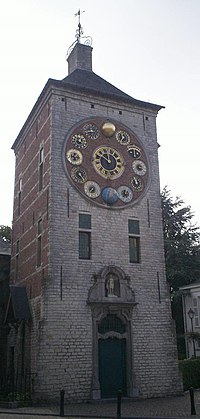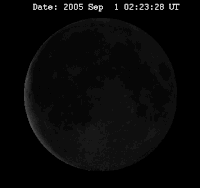Zimmer tower

The Zimmer tower (Dutch: Zimmertoren) is a tower in Lier, Belgium, also known as the Cornelius tower, that was originally a keep of Lier's fourteenth century city fortifications. In 1930, astronomer and clockmaker Louis Zimmer (1888–1970) built the Jubilee (or Centenary) Clock, which is displayed on the front of the tower.
The tower was built no later than 1425 though the precise date of construction is unknown. In 1812 the tower was sold by the municipal authorities, but after World War I, they repurchased it and slated it for demolition. However, in 1928 clockmaker Louis Zimmer presented to city, his work, the anniversary (Dutch: Jubelklok), which consists of 12 clocks encircling a central one with 57 dials. These clocks showed time on all continents, phases of the moons, times of tides and many other periodic phenomena. It was decided to place this new design in the old tower, which had to be substantially reconstructed for this. In honor of the astronomer they renamed the tower the Zimmer tower.

In 1960 a pavilion for the new clock was built next to the tower to present Zimmer's masterpiece the wonder-clock. (Dutch: Wonderklok) (these wonder-clocks were prepared for the 1935 world exhibition in Brussels; later they were demonstrated in the U.S.). Around one of these dials moves the slowest pointer in the world - its complete revolution will take 25800 years, which corresponds to the period of the precession of the Earth's axis. Subsequently Zimmer attached to the clocks a mechanical planetarium. The wonder-clocks impressed Albert Einstein, who congratulated Zimmer with the creation of these unusual mechanisms.
On the small square at the foot of the tower an exhibition of the solar system was arranged with the aid of metallic circles and the rings (circles designate the sun and planets, rings the orbits of planets). These also show asteroids Felix (№ 1664) and Zimmer (№ 3064), which were named after Felix Timmermans and Louis Zimmer when discovered in 1929, and 1984. In 1980 the tower obtained the status of state protected monument. Now the Zimmer tower and pavilion with the wonder-clocks is a museum.
Description of the dials
The Centenary clock has one large dial in the centre (1.5 m diameter). This dial shows the exact time (UTC+1, during daylight saving time UTC+2 is used instead). The twelve dials around the centre dial show the following (starting from the dial in the 2 'o clock position and going clockwise): the equation of time, the zodiac, the solar cycle and the dominical letter, the week, the globe, the months, the calendar dates, the seasons, the tides, the age of the moon, the phases of the moon and the metonic cycle and the epact.
This dial shows the difference in minutes between the apparent solar time and the mean solar time. Positive values indicate that the apparent solar time is ahead (fast) of the mean solar time, with maxima around November 3 and May 15. Negative values indicate that the apparent solar time is behind (slow) of the mean solar time, with a maximum lag around February 12 and July 27.
The difference is zero four times a year; around April 16, June 15, September 1 and December 25.
Every year the sun describes an imaginary circle around the earth, called the zodiac. The zodiac is divided in twelve segments, each denoted by a sign associated with a constellation. This dial shows the zodiac signs. The signs of spring; Ram, Bull and Twins. The signs of the summer; Crab, Lion and Virgin. The signs of the fall; Balance, Scorpion and Bowman. The signs of winter; Capricorn, Water-bearer and Fishes. One revolution of this dial takes a year.
The solar cycle and the dominical letter
The solar cycle is a 28-year cycle. After the 28 years, dates reappear in the same order. On the inner circle, the hand indicates the current year of the solar cycle. On the outer circle, the hand shows the corresponding dominical letter. The dominical letter gives the day upon which the first Sunday of the year falls. The letter A means that the first Sunday of the year will fall on January 1. The letter E for example, indicates that the first Sunday will be on January 5. Leap years have two dominical letters because the dominical letter changes end February. The first letter covers January and February, the second covers March to December. For leap years, the outer circle will show two dominical letters.
This dial marks the seven days of the week, represented by ancient gods and their symbol.
| Day | God | Symbol |
|---|---|---|
| Sunday | Apollo | sun |
| Monday | Diana | moon |
| Tuesday | Mars | lance |
| Wednesday | Mercurius | golden staff |
| Thursday | Jupiter | flash of lightning |
| Friday | Venus | mirror |
| Saturday | Saturn | sickle and scythe |
The rotation of the Earth causes day and night. It is day on the part of the globe that is currently visible. The places on earth that pass under the fixed meridian (the golden belt running from the North Pole to the South Pole) have noon at the same time. The globe rotates once every 24 hours.
This dial depicts the twelve months. The hand shows the current month. One revolution takes a year.
| Number | Month | Alternative name |
|---|---|---|
| 1 | January | Ice-month |
| 2 | February | Duck-month |
| 3 | March | Fish-month |
| 4 | April | Harlequin-month |
| 5 | May | Flower-month |
| 6 | June | Shearing-month |
| 7 | July | Hay-month |
| 8 | August | Harvest-month |
| 9 | September | Fruit-month |
| 10 | October | Wine-month |
| 11 | November | Slaughter-month |
| 12 | December | Resting-month |
This dial shows the exact date. The numbering goes to 31, the maximum number of days in a month. In months that have less days (28, 29 or 30), the hand automatically moves forward to the first day of the following month.
The dial shows four drawings by Felix Timmermans, representing the four seasons. Spring is represented by a child with flowers (upper left). The duration of the season is indicated with arabic numbers for the days and roman numbers for the hours. Spring lasts for 92 days and 11 hours. The summer is represented by a mower and lasts 93 days and 8 hours. Autumn is symbolised by a cornucopia and lasts 89 days and 10 hours. Winter is represented by an old lady reading by the fireside. The duration of the winter is exact 90 days.
On the dividing lines between the drawings is a small globe indicating the part of the globe that is being lit by the sun at the start of the season. The differences in illumination during the year are caused by the Earth's axial tilt. The hand completes one revolution a year and shows the current season.
The dial indicates the tides at Lier, Belgium. The biggest ship and the flag without the streamer indicate high water. When the streamer is above the flag it is flood. It is ebb when the streamer is below the flag. At Lier, the water is rising for 3 hours and 53 minutes and falling in the other hours. This dial completes almost two revolutions a day.

The time between two full moons is about 29 days, 12 hours, 44 minutes. This is the time it takes the Moon to make one orbit around the Earth. The dial shows how many days passed since last new moon, indicating the day in the cycle of the moon and showing on the inner circumference the phases of New Moon ([Nieuwe Maan] Error: {{Lang-xx}}: text has italic markup (help), N.M.), First Quarter ([Eerste Kwartier] Error: {{Lang-xx}}: text has italic markup (help), E.K.), Full Moon ([Volle Maan] Error: {{Lang-xx}}: text has italic markup (help), V.M.) and Last Quarter ([Laatste Kwartier] Error: {{Lang-xx}}: text has italic markup (help), L.K.).
This globe, colored halve gold and halve blue with golden stars, shows the phases of the moon. The golden part represents the visible part of the moon.
The metonic cycle and the epact
The hand on this dial revolves once in 19 years. After this period, the different phases of the moon will fall again on the same dates in the year. The Greek astronomer Meton proved this in 432 BC. On the outer ring, the hand points to the golden number, or the number of the current year in the metonic cycle. The inner ring shows the epact, which is the age of the moon on the first of January of the current year.
References
Ceulemans, Luk (1980). Louis Zimmer. vzw Gilde "Heren van Lier"
Zimmertorencomité (1982). Stad Lier, zimmertoren en wonderklok
External links
- Official Website Zimmertower
- The Zimmer Tower
- Louis Zimmer and the Centenary Clock, at Famous Belgians
